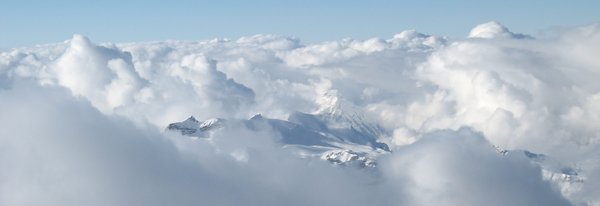
© Stephan Mertes


© Stephan Mertes
In order for a pure cloud drop to form in the atmosphere, very high water vapor supersaturations of several hundred percent would be necessary. This process, called homogeneous nucleation, is physically possible, but unlikely with respect to our atmosphere. This is because there are aerosol particles in the atmosphere, on the surface of which water molecules accumulate at already low supersaturations (a few per thousand to a few percent) and can thus form cloud droplets. These particles are called cloud condensation nuclei (CCN). They offer a surface on which the water molecules from the gas phase can preferentially accumulate. Depending on the size and chemical composition of the cloud condensation nuclei, this happens with different efficiency. CCN (e.g. sea salt particles) exist everywhere in the Earth's atmosphere, but they vary in number and composition. Even before they are activated to form cloud droplets, they can grow through the accumulated water.
We are investigating worldwide the number concentrations of CCN and their origins. The interplay between the available water vapour and the number of particles determines the size of the resulting cloud droplets. Size and number of droplets is an essential property of clouds, which influences how strongly a cloud reflects sunlight, absorbs heat radiation and also if and when the cloud rains out. On the one hand we investigate how many aerosol particles can serve as cloud condensation nuclei, on the other hand we study the remaining particles after targeted collection and evaporation of cloud droplets to describe the original condensation nuclei more precisely.
A cloud is not a static structure. Anyone who has observed a cloud for a while knows this. However, not only the outer appearance of the cloud changes, but also its essential properties, due to the interaction with the surrounding air. We also get to the bottom of these changes caused by turbulence in real clouds with a measuring platform that we can dive into clouds and also the institute's own turbulent wind tunnel.
Here again the links to our research topics:
Lab-studies connecting hygroscopic growth and droplet activation
Cloud condensation nuclei: activation of ambient particles
Characterization of drop residuals in atmospheric clouds
In-situ measurements of cloud turbulence